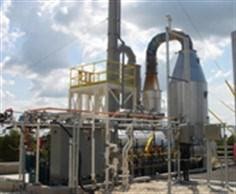 The Challenge
The Challenge
Many chemical and petroleum companies use batch reactors to make their products. These reactors typically have vents which are opened and closed during emptying, filling, mixing, heating or cooling and other steps of the production process. The gases coming from these vents must be controlled under most government regulations. Often the emissions produced are inert (little or no oxygen) streams with relatively low flow and high concentration of Volatile Organic Compounds (VOCs). In this case, the company was operating several reactors that required venting for depressurizing, filling and mixing. The process flow rate was less than 50 SCFM (80.25 Nm3/hr) and was essentially all light hydrocarbons such as methane, ethane and propane, with some halogenated hydrocarbons.
There are two oxidation strategies for this type of process stream, the first is to dilute the process vent with fresh air. This strategy provides oxygen for combustion and reduces the Lower Explosive Limit (LEL) below 50%, using a conventional oxidizer system. The National Fire Protection Association (NFPA) and FM Global guidelines suggest facilities keep vent collection systems airstreams below the 50% LEL for safety reasons. Because of the high BTU (British Thermal Unit) content of the process vent in this application, it would have required a high volume of fresh air to achieve the necessary LEL condition which would have dramatically increased operating expenses and raised safety concerns.
 The Solution
The Solution
While the above scheme is sometimes acceptable, Anguil implemented a different, safer strategy for this application. Instead of diluting the process vent with fresh air, designers kept the process stream inert, sending it directly through a burner port of a Direct Fired Thermal Oxidizer (DFTO). Essentially this allowed the combustion device to use the high BTU content as fuel for oxidation.
Once the DFTO is brought up to operating temperature with natural gas, the inert process gases are directed to the burner. During normal system operation, the VOC-laden process vent will fuel the pollution control device. During periods of low process flow or low energy content, supplemental fuel is added to the burner, natural gas in this case, to maintain operating temperature of 1400-1600°F (760°C-870°C) in the oxidizer combustion chamber. A minimum of one second residence time at these temperatures ensures a destruction efficiency of 99%+. An oxygen meter in the exhaust stack ensures that sufficient oxygen was present for complete destruction of the VOCs.
A soft refractory lining inside the oxidizer lets the operator start and stop the system without risk of refractory failure that can occur with other designs. This also allows them to shut down the oxidizer during substantial periods of process downtime without negatively affecting the longevity of the equipment.
For inert gases that contain no halogens or sulfur compounds the hot, purified, gas will be released to atmosphere from the combustion chamber or possibly sent to a heat exchanger for energy recovery. This particular application contained halogenated compounds, therefore the hot exhaust gases leaving the DFTO are directed into a hastelloy quench where they are cooled down before entering a packed bed scrubber.
The recirculation with a caustic solution inside the scrubber removes HCl (Hydrochloric Acid) and HBr (Hydrobromic acid). The scrubbed gases are then pulled into an Induced Draft fan and finally out an exhaust stack. An induced draft fan is used with halogenated streams so that there is no potential for corrosive gases escaping to atmosphere. Any leakage of acid gases will result in substantial risk to equipment longevity and to personnel. These scrubbing systems provide 99%+ removal of the acid gases prior to discharge to the atmosphere.
With these acid gases there is also a potential for corrosion of the oxidizer shell behind the insulation if the metal temperature is below the acid dew point. To prevent that from occurring, the oxidizer is designed with an external shroud to keep the carbon steel shell at a temperature above the acid gas dew point, avoiding corrosion concerns.
The Result
The Anguil System has a complete control system with communication capability to DCS (Distributed Control Systems) systems and modems for remote monitoring / diagnostics. These controls provide for automatic purge, system heat-up and a wide range of operating conditions. Magnetic driven scrubber recirculation pumps and scrubber controls are also provided for automatic operation without personnel adjustments.

